Tsutenkaku Tower: Observatory Info, Ticket Details, How to Visit

Tsutenkaku Tower is an iconic landmark of Osaka. This article highlights the unique features of Tsutenkaku, provides ticket information, and suggests activities. Additionally, we've included a one-day trip itinerary centered around Tsutenkaku Tower and its surroundings.
Tsutenkaku Tower - A Symbol of Osaka
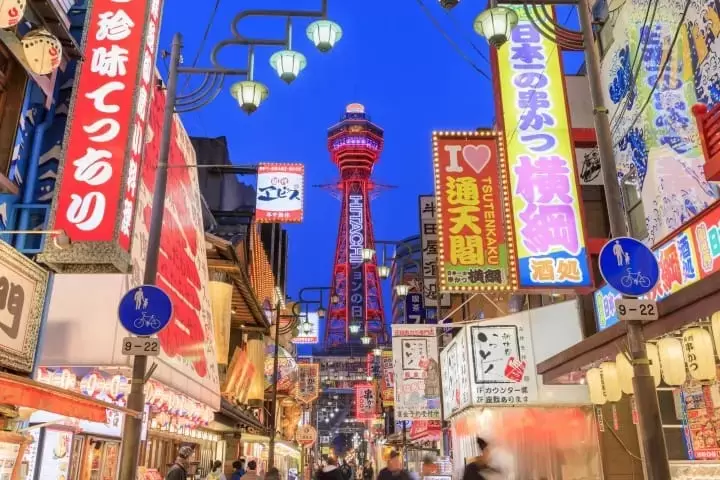
Photo by Pixta
Osaka boasts numerous famous locations such as Osaka Castle or Dotonbori but Tsutenkaku Tower would surely come to mind as a “symbol of Osaka.” This magnificent observation tower is 103 meters high, offering breathtaking views of the city.
Tsutenkaku is located near Shinsekai, an area that is fun to visit at any time of the year. It is easy to reach both Namba and Shinsaibashi from Shinsekai. It takes about fifteen minutes by train, so it's convenient to visit these three locations in one day.
Below we introduce seven exciting things to do at Tsutenkaku Tower, along with the features of the facility.
Tsutenkaku Tower Guide
1. Climb the Tsutenkaku Tower
2. Touch Billiken for Good Luck
3. Indulge in a Tsutenkaku Parfait
4. Learn about the History of Tsutenkaku Tower
5. Find Original Osaka Souvenirs
6. See the Weather Forecast at Tsutenkaku Tower
7. Stroll Around Shinsekai and Tennoji Park
8. Itinerary of one day trip to Tsutenkaku Tower and the surroundings
9. How to Get to Tsutenkaku Tower
10. Explore Tsutenkaku Tower
1. Climb the Tsutenkaku Tower

The entrance to Tsutenkaku Observatory Deck. Picture courtesy of Tsutenkaku Kanko Co., Ltd.
The first thing we suggest doing when visiting the area is, of course, climbing the tower itself!
The path leading to the observatory deck of Tsutenkaku Tower is a little unusual. You’ll notice a sign marking the observatory deck entrance. Please go to the basement first to buy an admission ticket. As of April 2020, the tickets are 800 yen for adults and 400 yen for children five years or older. After you paid the admission, go to the observatory deck by using the elevator.

This is the observatory deck located 88 meters above the ground. You can see the entire city of Osaka from here.
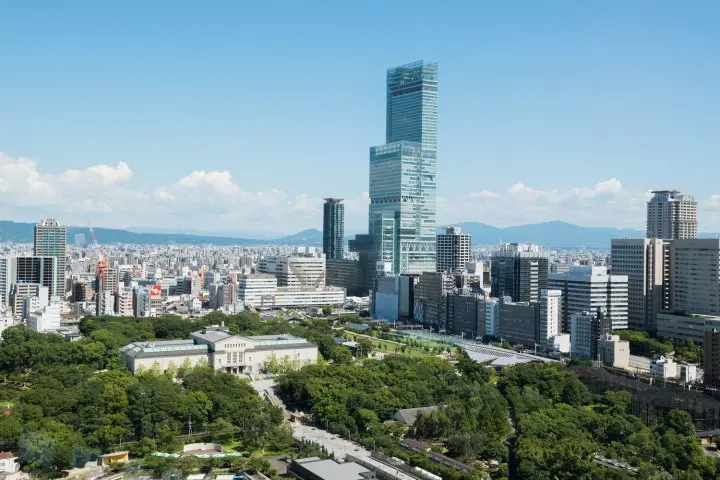
Photo by Pixta The tall building pictured in the center is Abeno Harukas.
From here, you can even catch a glimpse of the highest skyscraper in Japan, Abeno Harukas. The green area is Tennoji Park and Tennoji Zoo. Both are located at about ten minutes' walk away from the building.
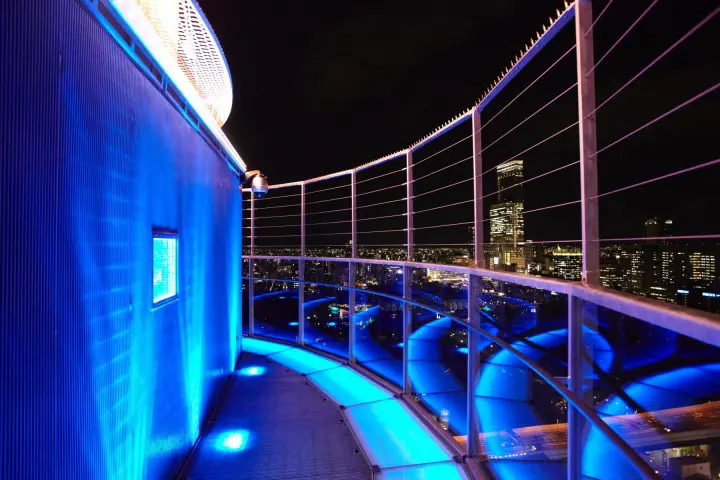
Picture courtesy of Tsutenkaku Kanko Co., Ltd.
If you pay an extra 500 yen, you can go up to the open-air observatory deck, Tenbo Paradise.
The whole floor of Tembo Paradise can be rented privately. It costs 10,000 yen and a reservation has to be made at least seven days in advance. If you want to surprise your partner with a special marriage proposal, consider the Tembo Paradise and its breathtaking view.
↑ Return to the top of article.
2. Touch Billiken for Good Luck
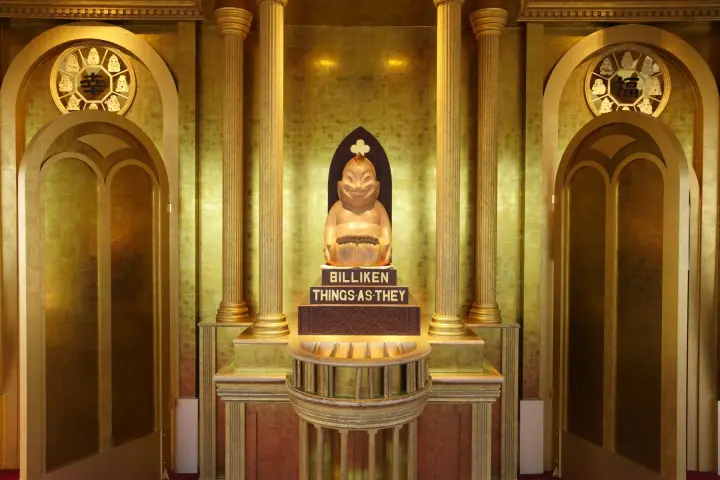
Picture courtesy of Tsutenkaku Kanko Co., Ltd.
Stop by the Billiken statue on the fifth floor of the observatory while at Tenkaku Tower. Billiken has a wide grin on his face. He is sitting with his legs pointing forward. These golden legs are said to bring luck to people. It is said that touching his feet brings good fortune.
Billiken has fans all over Japan but he is originally from the United States of America. He was created in 1908 by American illustrator Florence Pretz. The creator said that Billiken was a god he saw in a dream.
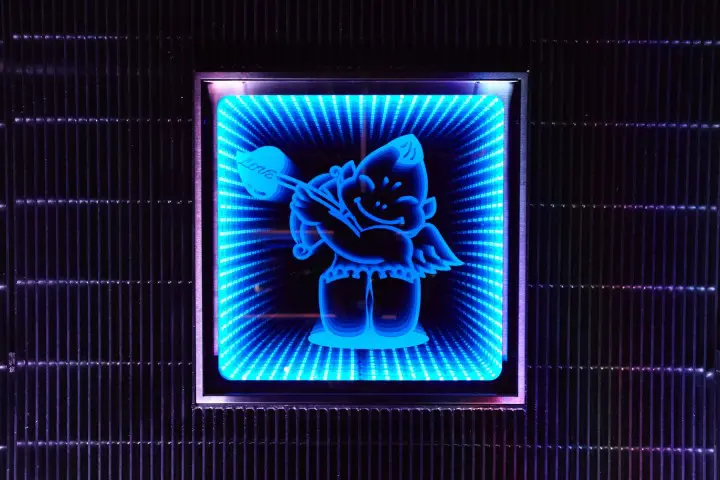
Picture courtesy of Tsutenkaku Kanko Co., Ltd.
It is said that in 1912, the Luna Park, a theme park built as an addition to Tsutenkaku Tower, had the first statue of Billiken on display. In the beginning, he was celebrated as the protector of families and guardian of business in Japan.
The one displayed on the observatory floor of the tower is the third Billiken statue. Every day there is a line of people waiting to touch his feet to get their share of good luck.
↑ Return to the top of article.
3. Indulge in a Tsutenkaku Parfait
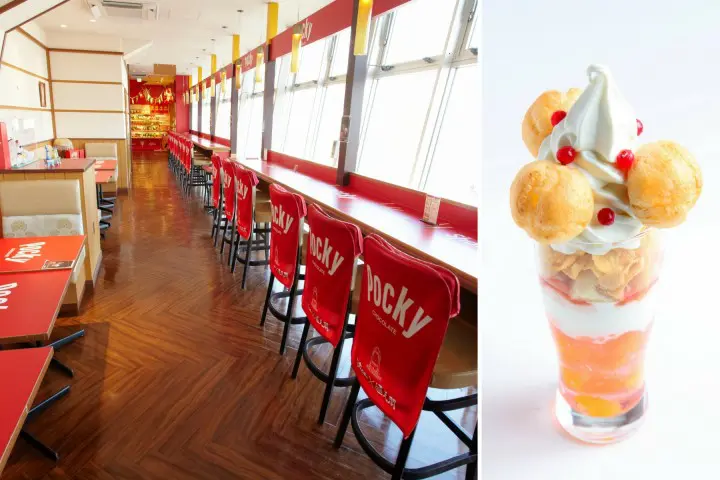
Picture courtesy of Tsutenkaku Kanko Co., Ltd.
A dish you will need to try when visiting the tower is the Tsutenkaku parfait (700 yen after tax). It is an exclusive, one-of-a-kind dessert you can savor only at the Café de Luna Park on the third floor of the tower.
Don’t be surprised when you see the size of this parfait. It is supposed to portray the tower itself with its magnificent twenty-one centimeters in height!
The first layer is made out of mixed fruit jelly topped with cornflakes and a sponge cake layer, which is then finished with a generous amount of soft-serve ice cream. There are cute petite cream puffs decorating the sides of this lovely dessert.
At the Café de Luna Park, you can also try some of Osaka’s famous mixed juice drinks, a mixture of rejuvenating fruits and fresh milk or yogurt as well as other local drinks listed on their menu. For those who are really hungry, they also offer dishes like pasta.
↑ Return to the top of article.
4. Learn about the History of Tsutenkaku Tower
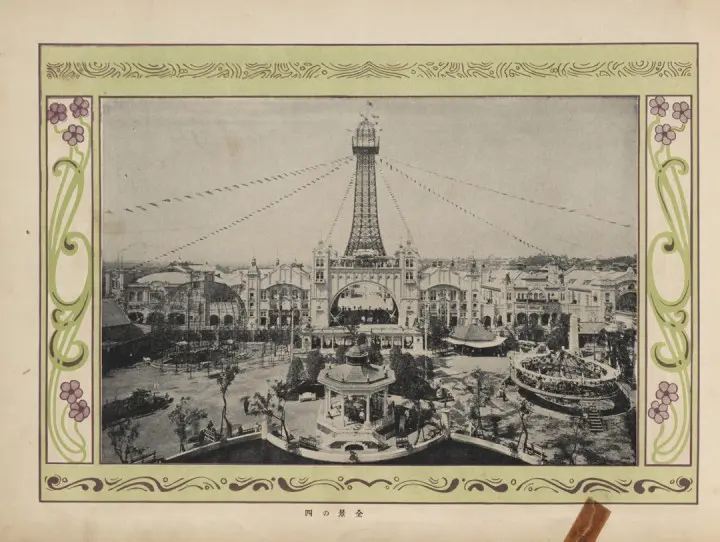
Picture courtesy of Tsutenkaku Kanko Co., Ltd.
The original Tsutenkaku Tower was built in 1912, standing approximately 75 meters tall. At the time, it was the tallest building in Japan, a remarkable feat that quickly made it a popular symbol of Osaka. Modeled after the Eiffel Tower in France, it featured a unique design, and its first floor included a replica of the Arc de Triomphe, adding to its grandeur. The tower served as the centerpiece of a bustling area surrounded by Luna Park, theaters, and shopping malls, attracting crowds and becoming a hub of activity.
Tragically, in 1943, the original tower was severely damaged by fire and dismantled shortly after. Its steel was repurposed to support war efforts during World War II.
The current Tsutenkaku Tower, rebuilt in 1956, was designed to stand taller and incorporate modern elements, while still paying homage to its predecessor. Today, it remains an iconic landmark of Osaka, representing the city's resilience and vibrant culture.
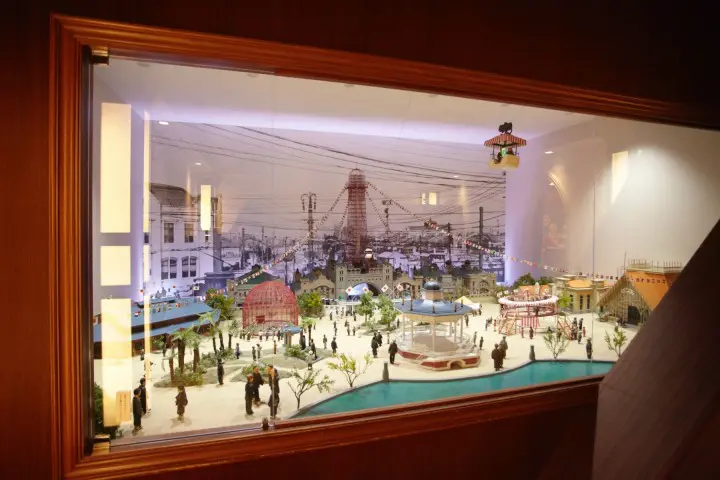
Picture courtesy of Tsutenkaku Kanko Co., Ltd.
This diorama, photographs, and materials on Luna Park are displayed on the same floor as the Café du Luna Park. This collection will leave you amazed at how different the Tsutenkaku and the Shinsekai area, as well as the Luna Park, looked just over a hundred years ago.
↑ Return to the top of article.
5. Find Original Osaka Souvenirs
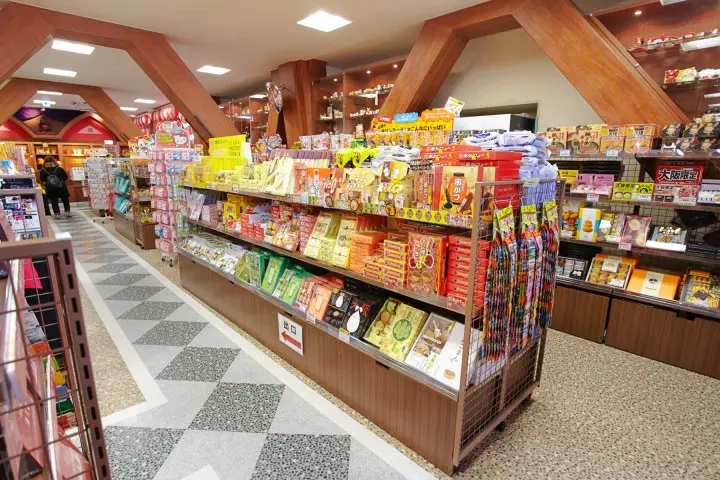
Picture courtesy of Tsutenkaku Kanko Co., Ltd.
If you’re looking for souvenirs, go up to the second floor of Tsutenkaku Tower.
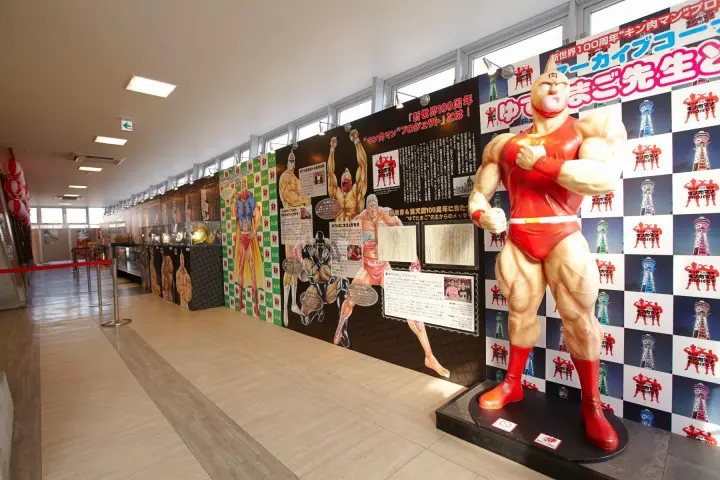
The character on the right is Kinnikuman. Picture courtesy of Tsutenkaku Kanko Co., Ltd.
Here you can find merchandise of the popular manga and anime character Kinnikuman as well as Tsutenkaku- and Osaka-exclusive goods. It's a great place to stock up on some gifts!
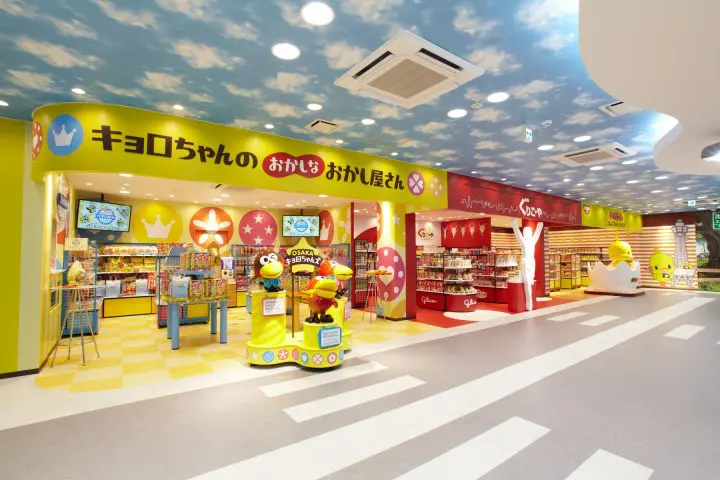
Picture courtesy of Tsutenkaku Kanko Co., Ltd.
On the first basement floor, you will find shops handling famous sweets and snacks of Osaka. These shops are filled with delicious, cute souvenirs. At the storefronts, you will be welcomed by characters such as Kyorochan, the Glico Man and Hiyokochan (the popular ramen chicken mascot).
↑ Return to the top of article.
6. See the Weather Forecast at Tsutenkaku Tower
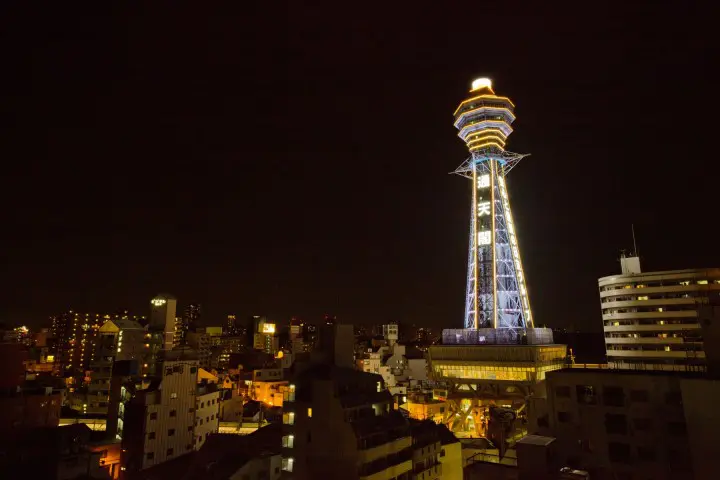
Picture courtesy of Tsutenkaku Kanko Co., Ltd.
If you visit Tsutenkaku Tower at night, make sure to look up! You’ll see a round neon light twinkling on top of the tower. If you know how to read the color of the light, it will tell you the weather forecast for the following day.
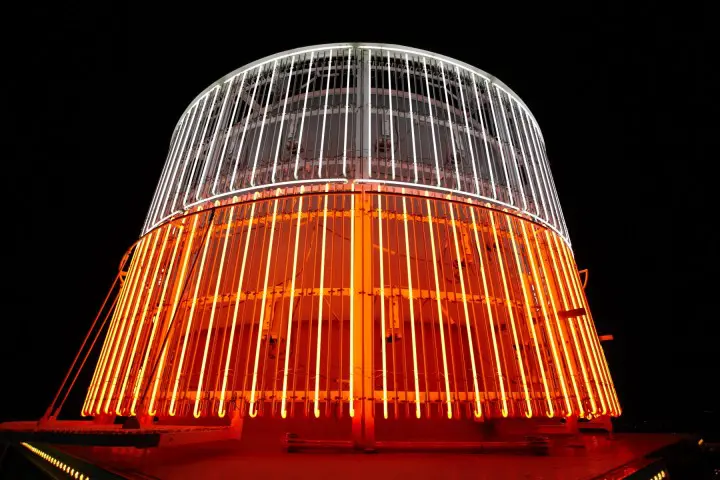
This color means that tomorrow the weather will be sunny, then cloudy, or sunny and partially cloudy. Picture courtesy of Tsutenkaku Kanko Co., Ltd.
White means sunny, orange stands for cloudy, and blue signifies rain. Sometimes you will see two colors shining down on you. For example, if the upper color is white, and the bottom color is orange, it either means it will be sunny in the first half of the day and then cloudy, or sunny but partially cloudy.
You can learn all about the next day's weather by carefully checking the partition of the colors. If you are at Tsutenkaku at night, be sure to check the weather with the help of these neon lights.
↑ Return to the top of article.
7. Stroll Around Shinsekai and Tennoji Park

The townscape of Shinsekai
While visiting Tsutenkaku Tower, we suggest taking a walk around Shinsekai. Discover great souvenirs and try local food at the shops lining the streets while enjoying the energetic local atmosphere.
When trying to describe the distinctive atmosphere of Osaka in Japanese, many people use the term “kote kote,” which roughly means "energetic, chaotic." Shinsekai is overflowing with this energy and is the perfect area to describe as kote kote.
Around the entrance to the Shinseikai area is a narrow street called Janjan Alley (Janjan Yokocho in Japanese). It is lined with shops selling kushikatsu (deep-fried skewers of meat or vegetables) and izakayas, or Japanese pubs.
Games including go and shogi have been also quite popular in this area for many years. Even today, you can see people playing shogi through the house and store windows.
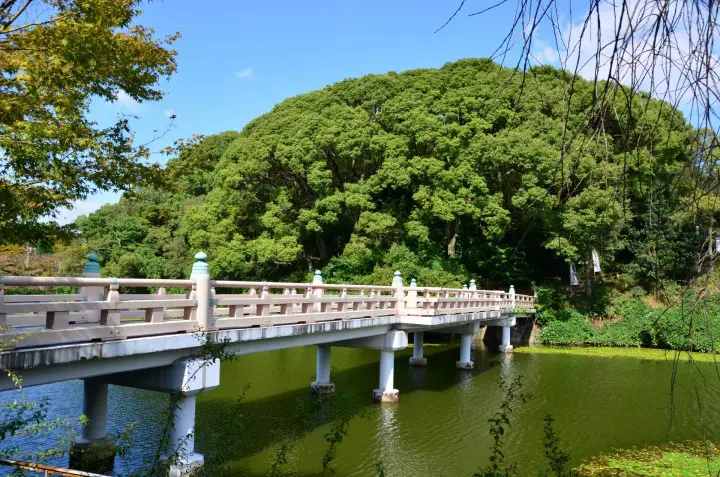
East of the Tsutenkaku Tower lies Tennoji Park, where visitors can take a break in the heart of nature.
The nearby areas around Shin Imamiya Station and Dobutsuen Mae Station have seen more backpackers and tourists recently, leading to a rapid increase in the number of affordable accommodations. This makes it a great place to stay, as well as a suitable starting point for sightseeing in Osaka.
Please note that the area is considered slightly unsafe and shady by the locals so be careful when walking around at night.
↑ Return to the top of article.
8. Itinerary of one day trip to Tsutenkaku Tower and the surroundings
10:00 AM – Take in the View from Tsutenkaku Tower
Start your day by enjoying the views of Osaka from the Tsutenkaku Tower observation deck. Here, you can also find the famous "Billiken" statue, a popular symbol of good luck among visitors. You will also find displays on the history and culture of Osaka, which will appeal to those interested in Japanese culture.
11:00 AM – Stroll round the Shinsekai Area
After visiting Tsutenkaku, continue exploring the Shinsekai area. This neighborhood offers a retro Showa-era atmosphere, with colorful signs and local street foods like takoyaki and kushikatsu lining the streets. It’s a unique and photogenic area that visitors find fascinating.
12:00 PM – Lunch Options: Kushikatsu or Kuromon Market
•Kushikatsu Lunch
Shinsekai is known for its kushikatsu, deep-fried skewers that are a must-try! Follow the "no double-dipping" rule and enjoy crispy kushikatsu at a popular restaurant. There are many places to choose from, whether you opt for a wide selection of dishes or a restaurant with shorter lines.
•Culinary stroll at Kuromon Market
For a variety of flavors, head to Kuromon Market, also known as "Osaka’s Kitchen." This lively market is perfect for trying fresh seafood, wagyu beef, sushi, and fruits while exploring the vibrant food stalls. It’s a popular spot for sampling various Japanese cuisine in small portions.
2:00 PM – Set out to the Dotonbori Area
Head over to Dotonbori to experience the heart of Osaka’s entertainment district. Known for the Glico sign and neon lights, the Dotonbori riverside is a great place to explore both day and night. Walk along the river, take photos, and check out souvenir shops. You can also enjoy a river cruise here.
6:00 PM – Dinner in Dotonbori
Finish the day with an iconic Osaka dinner of okonomiyaki (Japanese savory pancake) in the Dotonbori area. With many restaurants to choose from, look for one with good reviews or shorter lines. You’ll also find other local specialties, like takoyaki and yakisoba, to complete your Osaka dining experience.
How to Get to Tsutenkaku Tower
There are several stations you can use to get to Tsutenkaku Tower. If you head there from JR Osaka Station or Umeda Station (*1), as well as from Namba or Shinsaibashi, ride the Midosuji Subway Line from Umeda Station bound for Tennoji Nakamozu.
Get off at Dobutsuen Mae Station. It will take about fifteen minutes from Osaka or Umeda Station, six minutes from Shinsaibashi Station, and four minutes from Namba Station.
To reach the tower it will only take about ten minutes on foot from Dobutsuen Mae Station. We suggest taking this as an opportunity to stroll around the Janjan Alley and the Shinsekai area.
*1: Osaka Station and Umeda Station are connected. Be careful not to get lost at Umeda Station, as the station serves many different train lines.
↑ Return to the top of article.
Read also
FAQ
Is Tsutenkaku Tower worth visiting?
Tsutenkaku Tower is indeed worth a visit, embodying historical significance and architectural charm in Osaka's vibrant landscape. As an iconic symbol of the city, the tower offers panoramic views from its observation deck, showcasing Osaka's urban expanse. Nestled in the lively Shinsekai district, Tsutenkaku Tower provides a gateway to local culture, nostalgic vibes, and a range of culinary delights. Whether admiring the cityscape, delving into history, or immersing in Osaka's bustling atmosphere, a visit to Tsutenkaku Tower promises a memorable and enriching experience for all.
How long should I spend in Tsutenkaku Tower?
The amount of time you should spend at Tsutenkaku Tower ultimately depends on your interests and how thoroughly you wish to explore the tower and its surroundings. Generally, visitors typically spend around 1 to 2 hours at Tsutenkaku Tower, which allows for ample time to ascend to the observation deck, enjoy the views, check out any exhibitions or attractions within the tower, and perhaps indulge in some local snacks or shopping in the surrounding Shinsekai district. If you are short on time, a quicker visit of 30 minutes to an hour to admire the tower and its immediate surroundings is also feasible. Ultimately, tailor your visit based on what aspects of Tsutenkaku Tower and Shinsekai you find most appealing for a fulfilling experience.
Is Tsutenkaku Tower free?
While there is no general admission fee to enter the Tsutenkaku Tower premises or to stroll through the surrounding Shinsekai district, there are fees associated with specific attractions within the tower, such as the observation deck or experiences like the Tsutenkaku Slide. Visitors can enjoy the ambiance of Shinsekai and view the tower from outside at no cost. However, if you wish to access the observation deck for panoramic views, participate in tower activities, or explore certain exhibitions or experiences, there may be respective admission fees. It's recommended to check the latest pricing and offerings on the official Tsutenkaku Tower website or upon arrival for accurate details on any charges associated with specific attractions.
How do you get to Tsutenkaku Tower?
To reach Tsutenkaku Tower in Shinsekai, Osaka, visitors can utilize convenient transportation options such as the JR Loop Line or Midosuji Subway Line to Dobutsuen-mae Station, which is a short 5-minute walk to the tower. Alternatively, taking the Sakaisuji Line to Ebisucho Station provides easy access. Additionally, buses serving the area offer accessibility from various parts of Osaka. These transportation routes lead visitors to Tsutenkaku Tower, a famous landmark in the vibrant district of Shinsekai, ensuring a straightforward journey to this iconic destination.
Is it safe to go to Shinsekai?
Shinsekai in Osaka is a vibrant and historically significant district known for its unique atmosphere, local cuisine, and bustling entertainment. While Shinsekai has undergone revitalization over the years, it's essential to exercise common sense and awareness when visiting, particularly in the evening or late at night. Like any urban area, it's advisable to stay alert to your surroundings, keep belongings secure, and be mindful of your personal safety. During the day, Shinsekai is generally safe for visitors to explore and enjoy its lively streets, delicious street food, and iconic landmarks like Tsutenkaku Tower. As with any travel destination, being cautious and aware of your surroundings can help ensure a safe and enjoyable experience in Shinsekai.
↑ Return to the top of article.
Explore Tsutenkaku Tower
Visitors to Osaka have the chance to see and climb Tsutenkaku Tower. If you had your fill of other neighborhoods in Osaka, we suggest heading to this popular local area.
Tsutenkaku Tower and the surrounding Shinsekai area have a unique charm compared to Dotonbori and other popular areas. They overflow with the vibrant atmosphere of Osaka.
↑ Return to the top of article.
Hotels near Tsutenkaku
Read also
The author of the original article: Hitoshi Kinoshita (Japanese)
This article is an updated version of an article published on June 4t, 2014.
This is the official account of MATCHA's editorial department. Our articles feature useful travel information for visitors to Japan, from how-to guides to recommended places to visit.







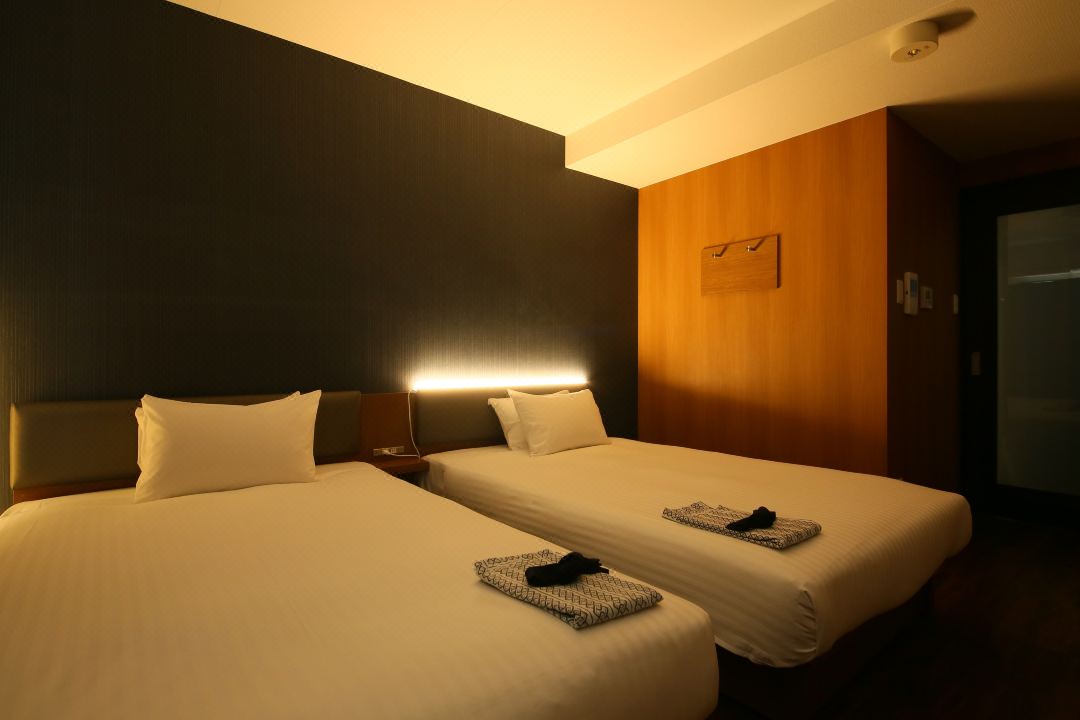
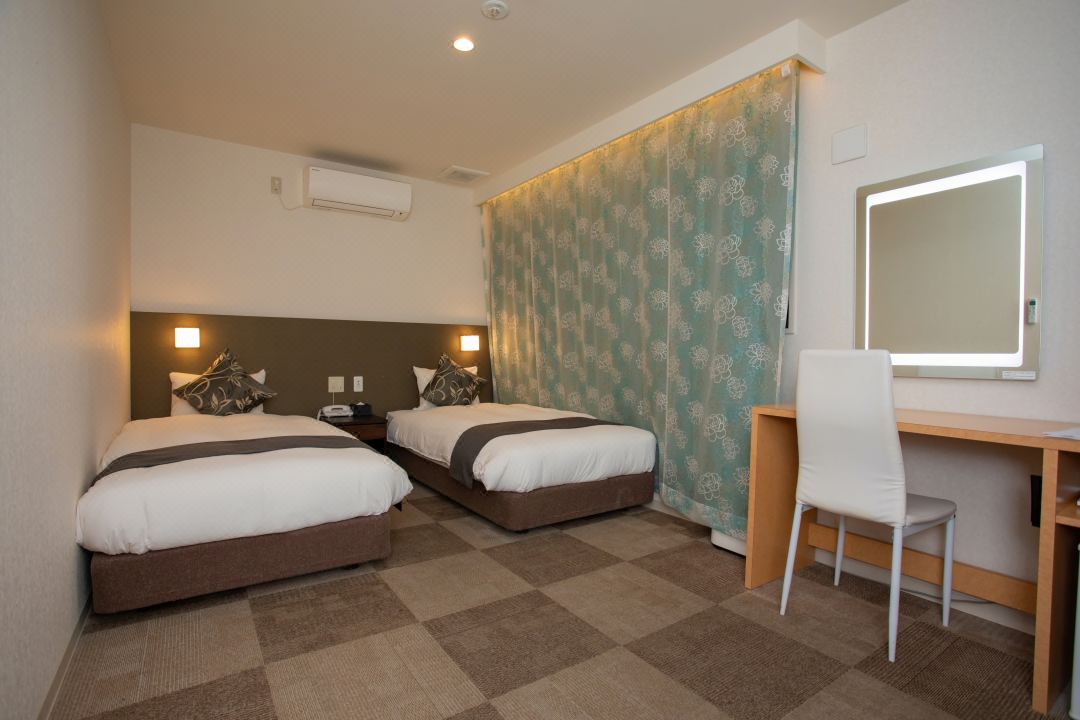


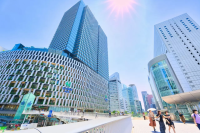


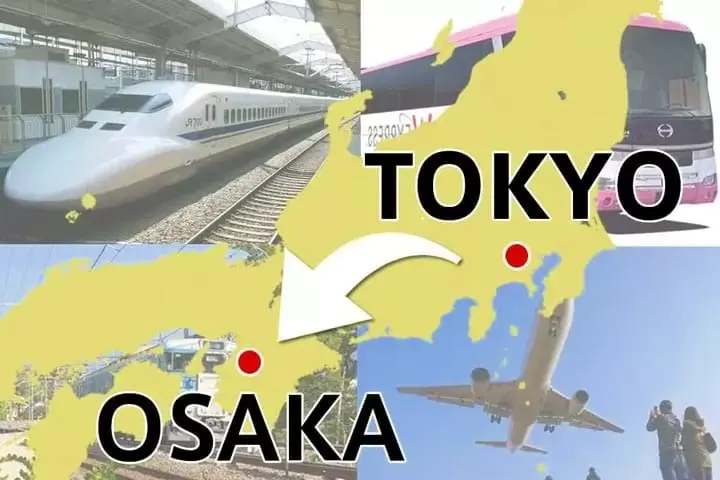
































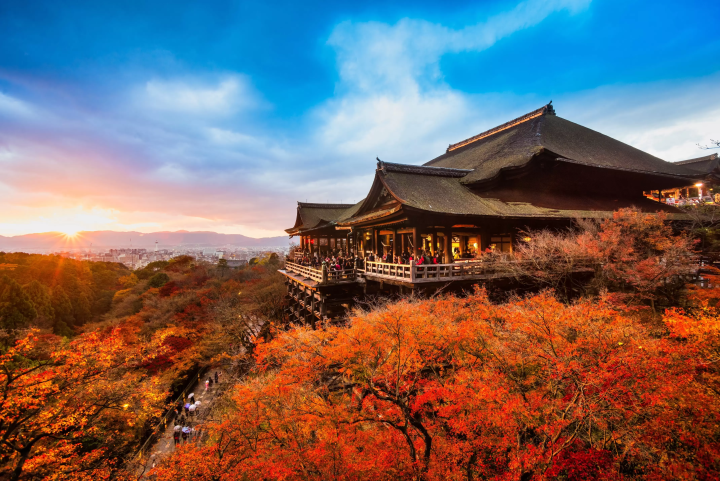
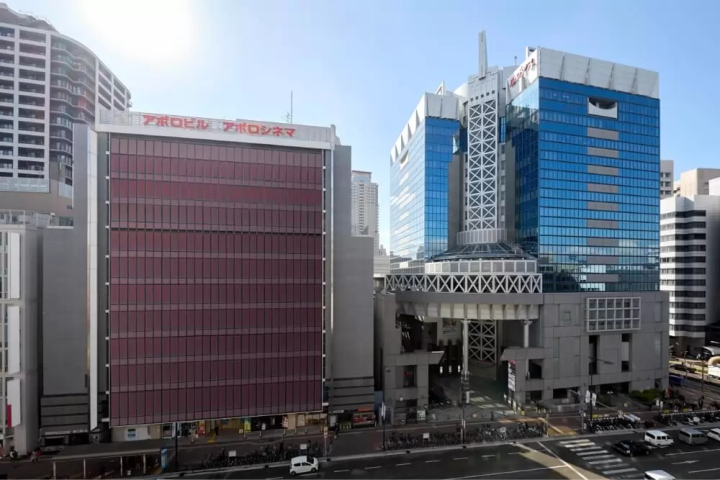
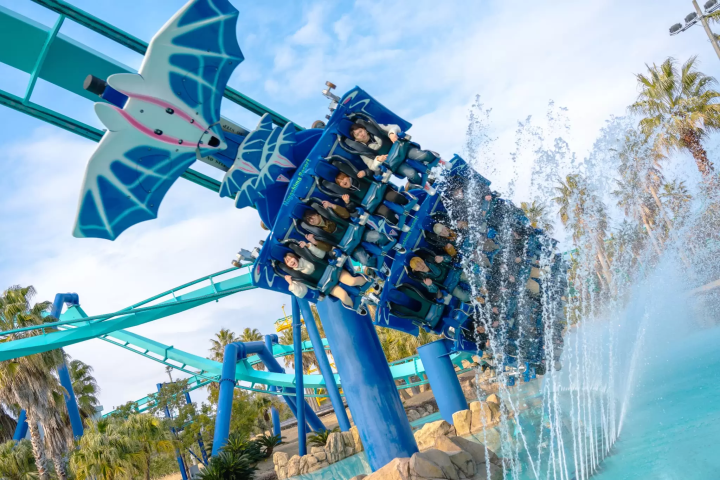
![[Next event confirmed! / Report] “Let’s Eat Tokyo Food”](https://resources.matcha-jp.com/resize/720x2000/2025/12/26-254125.webp)
![[Kanazawa] Enjoy the world of gold leaf to the fullest in the city with the highest production volume in Japan](https://resources.matcha-jp.com/resize/720x2000/2025/11/12-249564.webp)